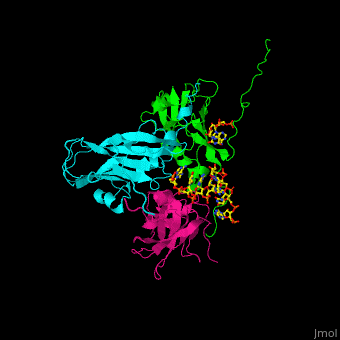|
|
| (47 intermediate revisions not shown.) |
| Line 1: |
Line 1: |
| - | <Structure load='1CWP' size='500' frame='true' align='right' caption='Insert caption here' scene='Insert optional scene name here' /> | + | <StructureSection load='' size='350' side='right' caption='Cowpea chlorotic mottle virus coast protein trimer complex with RNA (PDB entry [[1cwp]])' scene='47/472643/Cv/1'> |
| | + | == Function == |
| | | | |
| - | ===Self-Assembling Cowpea Chlorotic Mottle Virus Capsid: Nanoreactor and Scaffold for Molecular Synthesis===
| + | '''Cowpea chlorotic mottle virus''' (CPMV) infects black-eyed pea plants. The CPMV is composed of protein shell (capsid) and RNA. |
| | + | <scene name='47/472643/Cv/2'>Cowpea chlorotic mottle virus coast protein trimer with RNA</scene> (PDB entry [[1cwp]]). |
| | + | == Relevance == |
| | | | |
| - | '''Introduction'''
| + | CPMV is used in nanotechnology due to its pH and metal ion-dependent polymorphism which can be used for delivery of small molecules. <ref>PMID:7743132</ref> |
| | + | </StructureSection> |
| | + | ==3D structures of CPMV== |
| | + | Updated on {{REVISIONDAY2}}-{{MONTHNAME|{{REVISIONMONTH}}}}-{{REVISIONYEAR}} |
| | | | |
| | + | [[1ny7]], [[2bfu]], [[5ms1]], [[5msh]] – CPMV small + large subunits<br /> |
| | + | [[5a33]] – CPMV small + large subunits – Cryo EM<br /> |
| | + | [[6qoz]] – CPMV small + large subunits + affimer binding protein – Cryo EM<br /> |
| | + | [[1cwp]] – CPMV coat protein + RNA<br /> |
| | + | [[1za7]] – CPMV coat protein (mutant)<br /> |
| | | | |
| - | | + | == References == |
| - | <scene name='Cowpea_Chlorotic_Mottle_Virus/Protein_and_rna/1'>Protein Core with Stabilizing RNA Interactions</scene>
| + | <references/> |
| - | | + | [[Category:Topic Page]] |
| - | | + | |
| - | | + | |
| - | <scene name='Cowpea_Chlorotic_Mottle_Virus/Isolated_rna/1'>Isolated RNA</scene>
| + | |
| - | | + | |
| - | | + | |
| - | '''General Capsid Structure'''
| + | |
| - | | + | |
| - | <scene name='Cowpea_Chlorotic_Mottle_Virus/Full_capsid/2'>Assembled Capsid</scene>
| + | |
| - | | + | |
| - | The viral capsid of CCMV is a complex of proteins stabilized by metal coordination between capsomeres and RNA binding on its internal surface. The viral genome encodes three capsid proteins that are chemically identical. These subunits, arbitrarily called A, B, and C, dimerize with each other and assemble into into hexamers and pentamers that comprise the viral capsomeres. The complete capsid structure takes the form of a truncated icosahedron (20 faces). It is described as a T=3 capsid, where the T value is an indicator of structural complexity.
| + | |
| - | "A T-number or the triangulation number which determines the size of an icosahedron is defined as: T=h^2 + hk + k^2"
| + | |
| - | -Fumio Arisaka, Tokyo Institute of Technology.
| + | |
| - | | + | |
| - | | + | |
| - | '''Capsomere Structure'''
| + | |
| - | | + | |
| - | The hexameric capsomeres are formed by the B and C subunits. The N-terminus arms (residue 27 through 49) of the subunits intertwine to form a ring structure. The N-terminus is therefore key to the hexamer composition.
| + | |
| - | | + | |
| - | <scene name='Cowpea_Chlorotic_Mottle_Virus/Residues_27-49/1'>N-terminus arms</scene> | + | |
| - | The atoms of residues 27-49 are colored blue for clarity.
| + | |
| - | | + | |
| - | Each hexamer consists of six beta strands that run parallel to each other and result in a pore in the center of the hexamer. Residues 29-33 line this pore and reinforce the hexamer subunits by the interaction of their side chains with adjacent residues. For example, the "side chain oxygens of Gln29 residues hydrogen bond with the main chain nitrogens of adjacent Gln29 residues, making a circular ring of interactions" and the "valine residues stack upon one another inside the the beta-tube forming a circle of hydrophobic bonds."
| + | |
| - | | + | |
| - | In the <scene name='Cowpea_Chlorotic_Mottle_Virus/Interior_of_beta_barrel/1'>interior of beta barrel</scene>we can see these lining residues: glutamine 29 (in red), valine 31 (in orange), and valine 33 (in green).
| + | |
| - | | + | |
| - | Pentamer capsomeres, on the other hand, are formed exclusively from the contribution of A subunit chains.
| + | |
| - | <scene name='Cowpea_Chlorotic_Mottle_Virus/Pentamer/1'>Pentamer capsomeres</scene> also contain the same beta barrel structure but the amino-terminus arms cluster to create 5-fold symmetry. The positively charged Lys 42 residue is colored in blue as a marker for the N-terminus arms. The 41 amino acids before this residue do not have detectable electron density for the techniques used to render the structure.
| + | |
| - | | + | |
| - | | + | |
| - | | + | |
| - | Hexamer formation predominates the structure. It serves as the nucleation point for capsid construction.
| + | |
| - | | + | |
| - | | + | |
| - | *All Structural Content Derived from Speir et al.
| + | |
| - | "STRUCTURES OF THE NATIVE AND SWOLLEN FORMS OF COWPEA CHLOROTIC MOTTLE VIRUS DETERMINED BY X-RAY CRYSTALLOGRAPHY AND CRYO-ELECTRON MICROSCOPY"
| + | |

